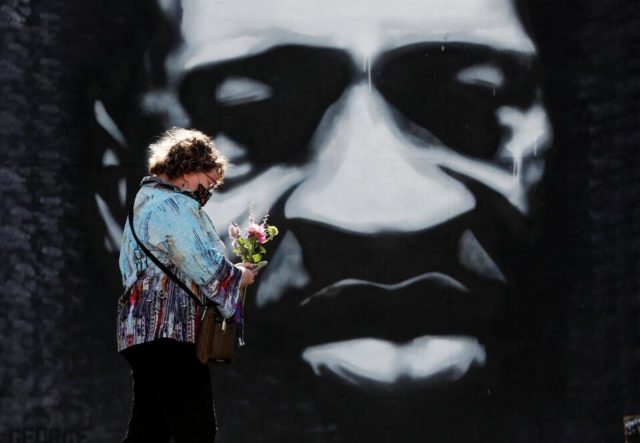WARNING: The video in this article is of a graphic nature. Reader discretion is advised.
Minneapolis – Newly released video of George Floyd’s fatal interaction with Minneapolis police shows that medical personnel waited nearly three minutes to perform chest compressions in an attempt to revive the handcuffed man who had been pinned down on a Minneapolis street until he lost consciousness in May.
The body camera footage captured by two of the four officers charged in Floyd’s May 25 death was released on Monday by order of Hennepin County Judge Peter Cahill, who is overseeing the criminal case over Floyd’s death.
The Minneapolis Police Department had previously declined to release body camera footage from the officers, citing the ongoing investigation.
The two approximately 30-minute clips present an even more desperate scene than previously depicted in bystander and surveillance video of the deadly Memorial Day encounter, which has fuelled widespread protests calling for police policy changes and transformed national conversations about race, social justice and police brutality.
The footage comes from body cameras worn by Alexander Kueng and Thomas Lane, the officers who were the first to encounter Floyd on a Minneapolis street as they investigated a 911 complaint about a fake $20 bill passed at a convenience store.
Derek Chauvin, then a 19-year-veteran of the Minneapolis police, has been charged with second-degree murder and manslaughter. The three other officers at the scene – Kueng, Lane and Tou Thao – have been charged with aiding and abetting. All four were fired by the Minneapolis Police Department and are scheduled to be back in court September 11.
In Lane’s video, the officer pulls a gun on Floyd within 15 seconds of encountering him in a parked vehicle, without announcing who he was or what he was investigating. Lane’s move prompts the 46-year-old Black man to cry, panic and beg officers not to kill him. Floyd appears visibly shaken and terrified of police, whom he repeatedly calls “sir” and “Mr. Officer”.
Floyd appears increasingly anxious and afraid of the officers and complains of being claustrophobic as they try to place him in a squad car, a move that he fights against. The footage shows Floyd say at least 25 times that he cannot breathe while he is restrained, telling the police he had been diagnosed with covid-19, the disease caused by the novel coronavirus.
After officers pin him to the ground, Floyd moans and begs for his life as Chauvin keeps his knee on Floyd’s throat for more than nine minutes – a longer time than previously estimated.
“They’ll kill me. They’ll kill me,” Floyd gasps, a few seconds before he goes motionless.
When an off-duty firefighter at the scene press the officers to check Floyd’s pulse, Kueng says he couldn’t find one. Chauvin keeps his knee on Floyd’s neck for at least another two minutes after that, the video shows, even as Kueng and Lane appear to ease their weight off Floyd’s body.
Chauvin removes his knee when medical personnel arrive, but chest compressions do not begin until a worker instructs Lane to perform CPR on Floyd in the back of the ambulance.
Floyd was pronounced dead at a hospital about an hour later – 9:25pm, according to police.
Hennepin Healthcare Emergency Medical Services, which dispatches ambulances in Minneapolis, did not respond to messages requesting comment on workers’ handling of Floyd.
Earl Gray, an attorney for Lane, filed the footage last month as evidence supporting a motion to have charges against his client dismissed, making the footage public record under Minnesota law. Lane, who had been on the force for less than a week, twice asked Chauvin whether the officers should shift Floyd’s body as they held him to the ground, citing concerns about “excited delirium”, a term used by medical examiners to describe the sudden in-custody death of people who may be under the influence of drugs or in an agitated state.
Cahill, the judge, initially resisted allowing videos to be released widely, citing concerns about jeopardizing the former officers’ rights to a fair trial. A consortium of local and national media filed a motion calling on the court to release footage, calling the refusal a violation of public records laws and the First Amendment. The judge responded by making the videos available by appointment July 15 at a downtown Minneapolis courthouse.
But in a July 21 court hearing, Leita Walker, a Minneapolis attorney representing the media, argued to make the footage more widely available – pointing out that reporters were given just one hour to watch the one hour and four minutes of footage.
“We are dealing here with evidence that is central to a criminal case that [spawned] the largest civil rights movement in the history of the country,” Walker said. “And this court is giving journalists an hour to watch it.”
Walker argued that videos of Floyd’s death have already circulated for months in the media and have been viewed by millions of people, including likely jurors. “People have already seen George Floyd die at the hands of police,” Walker told the judge. “The cat is out of the bag. We have seen it.”
Last week, the Daily Mail published what the site described as leaked footage of the videos, apparently filmed from a laptop inside the courthouse. On Friday, Cahill announced that the videos would be released. A third video of body-camera footage, this one captured by a device worn by Thao, has also been filed as evidence in court, but the judge has not ruled when it might be publicly released.








